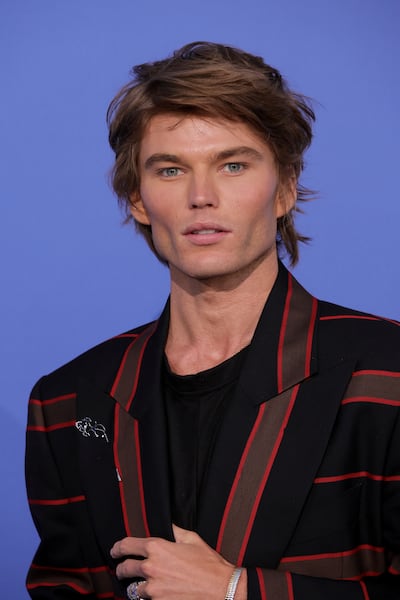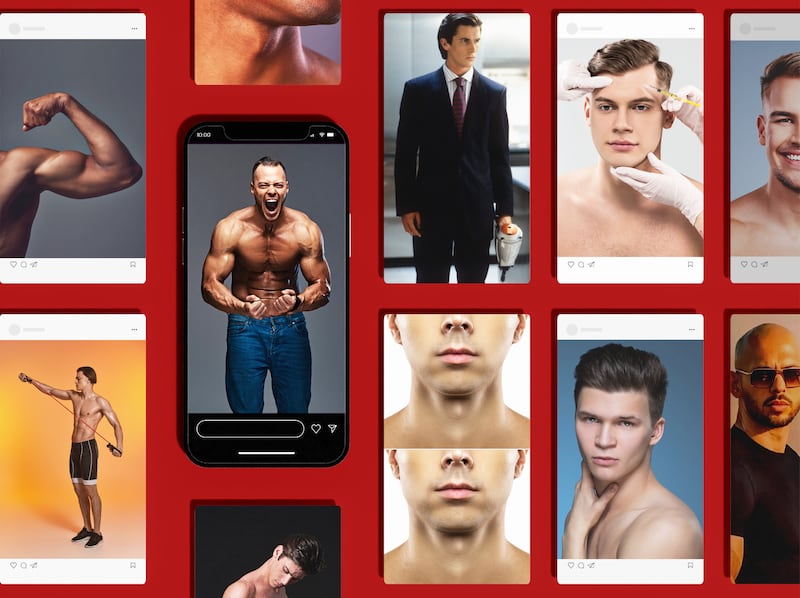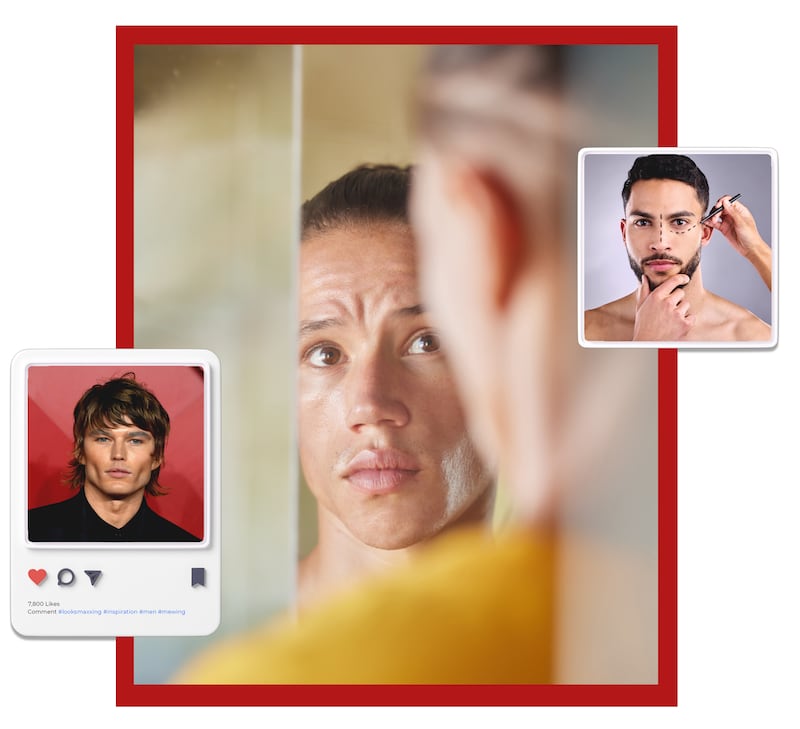How do I look? How can I improve myself? How do you rate me? How can I become more attractive?
These questions have long been common in online chat rooms across the world. But where it traditionally was mostly young women seeking reassurance, it is now a growing trend among young men.
Aged from mid to late teens and upwards, an increasing amount of validation is being sought online from peers. Many are ruthlessly torn apart for their looks, others are told to “hit the gym” or “bulk up”, while a growing number are embracing the TikTok trend of ‘looksmaxxing’, the process of optimising one’s physical attractiveness to increase their desirability to women and social standing among male peers. The basic belief being, the better you look, the better society will treat you.
On the surface, the movement may seem harmless enough. Basic grooming advice, referred to within the community as “softmaxxing”, includes haircare, showering daily, exfoliating regularly, dressing well and always wearing deodorant and aftershave, as well as incorporating into one’s lifestyle tips and tricks like adding lifts to shoes to appear taller. Popular softmaxxing videos get millions of views, sharing advice on how to begin the process with common beauty utensils like jade rollers and gua shas to promote blood circulation and target puffiness.

One TikTok star, Dillon Latham, with the username dillon.latham, an 18-year-old American self-improvement guru, with more than 1.4 million followers and 90 million likes, adds videos about how wearing adhesive nose-strips can open the nasal passageway and help you breathe and sleep better.
So far, so innocent. But these are no ordinary strips. They can, according to Latham’s video, “optimise the structure of your face” by allowing teeth to align properly, among various other supposed health benefits. These, Latham wears while chewing “the world’s hardest gum” or mastic gum, a liquorice-flavoured resin used in alternative medicine to help digestion and prevent tooth cavities. In the world of #looksmaxxing, it has found a new purpose, purportedly helping users to achieve the defined jawline and hollowed cheeks that represent their ideal image of masculinity.
Latham leads with harmless beauty advice, joining poster boys for the community, who include Australian model Jordan Barrett, often hailed as the face of the trend, with memes used across social media displaying his chiselled, supermodel looks, and the so-called “hunter” or “preying” eyes (think squinting in the sun), so prized among looksmaxxing’s disciples.
[ What causes us to age? Scientists search for answersOpens in new window ]
Also feted by some is the fictional Patrick Bateman, the antihero played by Christian Bale in the movie adaptation of Bret Easton Ellis’s novel American Psycho, whose fondness for torturing women and killing homeless people is conveniently overlooked as forum-users instead laud his obsessive grooming regimen.
This new young fan base post videos of themselves wearing face masks or combing their hair and posing while lip-syncing to the movie’s famous monologue. “My name is Patrick Bateman. I’m 27 years old. I believe in taking care of myself and a balanced diet and rigorous exercise routine. In the morning, if my face is a little puffy, I’ll put on an ice pack while doing my stomach crunches. I can do 1,000 now.
“After I remove the ice pack I use a deep pore cleanser lotion. In the shower I use a water activated gel cleanser, then a honey almond body scrub, and on the face an exfoliating gel scrub. Then I apply an herb-mint facial mask, which I leave on for 10 minutes while I prepare the rest of my routine. I always use an aftershave lotion with little or no alcohol, because alcohol dries your face out and makes you look older. Then moisturiser, then an anti-ageing eye balm followed by a final moisturising protective lotion.”

Another Tiktokker, Kareem Shami, who goes by the username Syrianpsycho and has more than 1.5 million followers, with 102.9 million likes for his content, is also a big presence on Looksmaxxing channels. He credits jaw exercises, longer hair, dressing for his age, and a law degree for his aesthetic transformation. Videos feature his younger self with acne and insecurities before he delved face first into the numerous ways in which looksmaxxing claims can help anyone achieve physical perfection, and there are many.
One of the more popular ones is called “mewing”. Shami and many others offer tutorial videos on how exactly this works. “It’s not an exercise; it’s posture,” he shares in one of his posts, before adding, “If you’re not living under a rock you’ll know what it is”.
For those of us on the outside, or under a rock, “mewing” is an exercise technique of holding the tongue up to the roof of the mouth, which is claimed by some to help shape the maxilla, or upper jaw.
This is attributed, though not substantiated, to a British orthodontist, Dr John Mew, who began using the technique in the 1970s. His son Dr Mike Mew, also an orthodontist, became a huge hit on TikTok with more than two billion views of a video explaining the method behind it, which father and son use under an umbrella term of “orthotropics”. The younger Mew found himself before a General Dental Council (GDC), tribunal hearing in the UK last year over the technique and its potential risk to children. The pair are also the subject of an upcoming Netflix documentary called Open Wide.
On YouTube, the video Dr Mike Mew’s Ultimate Mewing Guide | Beginners, on his Orthotropics channel, claims mewing is a “postural technique” that involves placing the tongue on the roof of the mouth to gain health and facial improvements.
“The aim is to align the teeth, accentuate your cheekbones, sharpen your jawline, and even straighten your nose naturally. All without invasive surgery and expensive orthodontics,” he says. “This may also diminish wrinkles and improve your airways bringing the Maxilla forwards, potentially extending your lifespan by enlarging your airwaves, reducing snoring, and sleep apnoea. It works.”
Mew uses images of photos posted on chat rooms and social media sites such as Reddit and TikTok of success stories, where young women and men appeared transformed alongside pre-mewing pictures, with straighter noses and hollowed cheeks. That video, posted last December, already has more than six million views.
Mewing may sound far-fetched, but it has amassed a huge following online, with users more than happy to share tips, progress and describe how it has led to better aesthetics for them, which in turn has led to a better social life.
A deeper investigation of looksmaxxing starts to get really sinister, because the ethos and origin of this movement shares roots with the murky, and often dangerously misogynistic world of incels – short for “involuntary celibate” – where figures such as the controversial influencer Andrew Tate still maintain their powerful status.
Debbie Ging, a professor of digital media and gender in the School of Communications at Dublin City University, has compiled research on the “manosphere”, an umbrella term that refers to a number of online interconnected misogynistic communities.
“Incels are men who are sexually unsuccessful, and believe that this is predetermined by genetic factors dictating their physical appearance,” she says. “Because incels lack the physical attributes they think all women find attractive – tallness, muscularity, strong jawlines – they believe they are doomed to a life of celibacy and loneliness.

Ging says that while there are no specifically Irish incel sites that she’s aware of, there are “undoubtedly many Irish incels who are active in the main spaces such as incels.is and various subreddits, Telegram channels and chan boards”.
“The reasons are diverse and complex, but social isolation and social awkwardness play a significant role,” she says. “There is a higher self-reported prevalence of psychological diagnoses among incels than in the general population. Some of this, for example, depression, may be the result of sexual failure and rejection. Histories of bullying are also common, and many incels talk about dysfunctional or unaffectionate relationships with their parents.”
There are many more sinister and worrying subsets of looksmaxxing beyond facial exercises and chewing extra-tough gum. “Hardmaxxing” is an extreme transformation process where surgery is used to achieve a supposedly irresistible look. Canthal tilt surgery, where the eyes are made more angular to achieve the “hunter” look, or spinal stretching to add height, are common discussions on incel forums.
“Mogging” is where you stand next to a less attractive person, thus accentuating your own good looks. “Starvemaxxing” is where users cut down dramatically on food and water intake to lose body fat from the face: some upload photos to forums to showcase their extreme weight loss.
Shock treatments also include “bonesmashing”, originally a joke that emerged from incel-led looksmaxxing forums more than a decade ago, but which has somehow entered the world of TikTok trends since late last year as one way to achieve the desired jawline. The dark humour of its twisted origins is lost on a younger generation now taking it seriously and self-harming in the process.
It’s so hard for them to get away from it, and these trends add another reason for boys and teenage men to feel inadequate
— Keith Russell
Worrying videos posted show users taking hammers to their face, or banging their jawbones with items to “break” and reset the bone into a more chiselled and pointed feature. In one video shared on Reddit, a 15-year-old looksmaxxer performs a DIY buccal fat surgery, a cosmetic procedure performed to hollow out cheeks in the face and give a more defined look. The surgical treatment removes fat pads in the lower cheek through an incision in the mouth.
Dubliner Keith Russell, a blogger and host of The Endless Spiral, a podcast about mental health, who suffers from body dysmorphia disorder, says the looksmaxxing trend puts even more pressure on young people who are already bombarded from social media.
“It’s so hard for them to get away from it, and these trends add another reason for boys and teenage men to feel inadequate,” he says. “I’ve seen things on TikTok, where you post your picture and people drag templates across it and rate you: that’s so degrading and disrespectful to that person. I actually saw an ad that popped up on Instagram for small rubber tubes the size of a golf ball and made of silicon. Their purpose was to redefine your jawline if you chewed on them. Even the photo of a guy in a gym with these things around his neck. I wasn’t even looking for this and I was subjected to it.”
Russell says a lot of his body issues as a young man were in his own head, but the dangers with looksmaxxing is how it can trigger something in a young person so easily.
“Men and boys are starting to feel like they are not enough,” he says. “Muscle dysmorphia is another dangerous area, where they are very self-conscious and they are milling protein shakes and eating lots of calories but for the wrong reason, to put on muscle and be bigger.”
While users share their insecurities and self-hatred freely on the forums, disclosing their vulnerabilities doesn’t protect them from becoming targets of other users. These forums can be brutal and sickening in their language and they are also liberally sprinkled with sexist remarks about women.
“It’s the idea of male supremacism and regaining lost power and control that is pulling them in,” says Ging. “Alpha ‘manfluencers’ such as Tate and his ilk are deliberately exploiting these financial and emotional insecurities by focusing on mental health, money making and stoicism. But all of this is premised on dominating women sexually, getting them back into the kitchen, and treating them as intellectually inferior.” Looksmaxxing and starvemaxxing hashtags have millions of followers, views and videos on TikTok – but the trends are extreme, from surgery to break a person’s jawbones to stretching the spine to make a person taller. Are young men going through an identity crisis?
“Most incels are certainly going through an identity crisis, and those men who reject progress or feel it is an attack on their rights are pushing back and trying to hold on to a mythical ideal of manhood that is bad not only for women and LGBTQ people but for themselves. Male supremacist ‘manfluencers’ reject therapy, say depression isn’t real and claim men don’t experience the same emotions as women – then blame depression and suicide on feminism. Their priority is making money, but what impact is this having on their followers?”

The issue of boys and men experiencing unhappiness with their body image and appearance has never been more apparent because of the existence of social media. In the US there is the rise of what’s being termed “bigorexia”, or muscle dysmorphia, where buff physiques become an obsessive pursuit often beyond what is achievable with gym workouts and supplements use. Hollywood stars such as Channing Tatum and Dwyane “The Rock” Johnson are held aloft as ideal looks – the bigger, the better.
Trends such as striving for muscle mass or electing for cosmetic surgeries are being increasingly linked to body dysmorphic disorder (BDD). According to Bodywhys, the Eating Disorders Association of Ireland, this illness, when a person has a distorted view of themselves, reinforces itself in people’s minds. Their thoughts, self-belief and quality of life become affected by the distress associated with the illness, which has several ripple effects, including the risk of suicide. People with BDD may try to access surgical or other procedures in the hope this will address their concerns or “fix” them.
“There are several potential contributory factors – the amplification of ideals and norms expected around the male body, such as in elite sport, popular culture, an emphasis on protein as something to be mindful of, that diet is something to be policed, increased perfectionism in society, men and boys engaging in risky behaviours linked to food, weight and the body, the sense that the body and oneself is something that can be continuously improved upon or pushed,” says Barry Murphy, research and policy officer at Bodywhys.
“It is vital that practices and attitudes which are misogynistic are called out and addressed, and it is also important that young men do not receive the message that masculinity is necessarily toxic. It isn’t
— Brendan Kelly
He suggests “proactive and open communication” between parents and their teenage boys when it comes to social media messaging or viral trends. These include “trying to understand why someone may be drawn to particular trends, encouraging media literacy and a curiosity about what’s depicted on a screen versus reality; encouraging boundaries around social media and reinforcing the message that changing one’s health or lifestyle should be based on credible information and sources; encouraging offline activities and education about algorithms; and finally, that comparison has its limits and one’s worth is not determined by social media metrics.”
Brendan Kelly, professor of psychiatry at Trinity College Dublin, says parents should inform themselves of what social content children and young people are watching and accessing, with an emphasis on listening to their viewpoints rather than trying to correct them.
“It is important for parents to be familiar with the kinds of technologies and social media that their children spend time with, and remain open to discussion when their children mention things they saw online,” he says. “Listening to young people, and genuinely seeking to understand their viewpoints, is far more impactful than trying to ‘correct’ them.
“Young people who spend large amounts of time perusing extreme material online need to be guided away from that, and towards more positive, realistic material. But, most of all, young people, men and women, need steady role models in their lives: parents, friends, teachers and others. Much as they might deny it, young people do what they see older people doing. Role models are essential.”
But Kelly says when considering masculinity, it is important to recognise that there is a range of behaviours rather than clearly identifiable “groups”.
“While terms like looksmaxing or bonesmashing come and go, most young men do not engage with them,” he says. “They regard them as irrelevant, extreme, or dangerous. Those who do engage with them need to be guided away from them and provided with alternative, credible role models.”
He adds that this is especially true when addressing male violence against both women and men.

“It is vital that practices and attitudes which are misogynistic are called out and addressed, and it is also important that young men do not receive the message that masculinity is necessarily toxic,” he says. “It isn’t.
“It is a mistake to imply that extreme activities such as ‘bonesmashing’ reflect all men. That approach drives young men to become more disengaged and more extreme, by tarring them all with the same brush.
“Certain activities and attitudes are clearly misogynistic and discriminatory, are damaging to both women and men, and should not be tolerated. But masculinity itself is not necessarily toxic. Most young men are intelligent, thoughtful and kind.”











